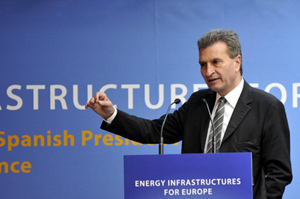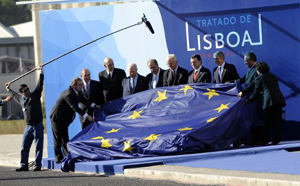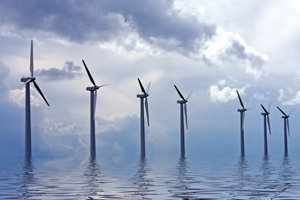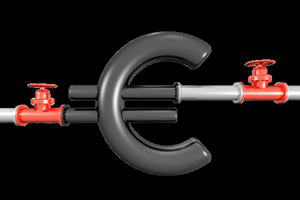Finally, Brussels’ battle plan for the European energy market
on
Finally, Brussels’ battle plan for the European energy market
The European Commission has set out its vision on how to develop the European energy networks needed for a low carbon and more import-dependent future. Brussels’ infrastructure battle plan, adopted on 17 November, is to focus on a limited number of priorities with high added value in terms of achieving European energy and climate change goals, to identify specific but flexible projects that enable the EU to adapt to a changing economic and technological environment and to create tools that can support this policy. Legislative proposals will follow soon. The stakes are high. Success or failure of the new infrastructure policy will be crucial to Europe’s entire strategy on energy efficiency, renewable energy, the Single Market, and security of supply.
 |
| This time Günther Oettinger presented a rather impressive new infrastructure package |
Up until now, European infrastructure policy consisted of lists of “priority projects” that were supported by a low level of funding from a very modest trans-European networks budget. Priorities were often ill-defined, however. There was a lack of long-term vision, a lack of flexibility in the designation of projects and, above all, delays in approval processes that hung like a millstone around the necks of the financial plans and discouraged investors.
In the last five years, of the 32 electricity projects and 10 gas projects of European interest (the highest priority), nine were completed and twelve are underway. That may seem not such a bad result, but it is
| It is clear that the role of Brussels in energy infrastructure has been insignificant so far |
Legal basis
So far the Member States have called the shots; now the added value of Europe is coming into play. A crucial step in this process has been the Lisbon Treaty, which added the interconnection of networks to the objectives of EU energy policy. This means the EU has a legal basis now to pursue these projects.
The infrastructure package makes it clear that huge investments are required: €600 billion until 2020 for transport, distribution and storage of electricity and gas (including smart meters). In addition, €500 billion of investment is needed in new generation capacity, but that’s a different story. So much money is needed, in fact, that the Council of European Energy Regulators (CEER) has warned that the costs ‘will have a significant impact on customers’ energy bills. It means that value for money needs to be built into the process, which can be delivered through regulatory oversight.’
Costs may be considerable, but the list of current energy challenges that stand to benefit from the new infrastructure policy is long: integration of offshore wind power form the North sea and hydro-energy from the Alps, an electricity backbone bringing together the whole European network, new routes for gas
| So much money is needed that the Council of European Energy Regulators has warned that the costs will have a significant impact on customers' energy bills |
Absurd situation
The infrastructure package distinguishes four short-term priority areas (electricity, gas, oil and smart grids) and two long-term priority areas (“electricity highways” and CO2-infrastructure).
With regard to electricity, the package proposes to realize four “electricity corridors”. These build on the development priorities defined in the ten-year plan of ENTSO-E, the European association of electricity transmission system operators. The corridors are intended:
- to connect the offshore wind power of the North sea and the hydro-storage sites in Scandinavia and the Alps with the main consumption centres in the heart of Europe
- to connect the production of renewable energy in the South of Europe with the North
- to achieve better East-West and North-South connections
- to complete the Baltic Energy Market Integration Plan (BEMIP)
 |
| The Lisbon Treaty added the interconnection of networks to the objectives of EU energy policy |
In fact, some NGO’s believe the electricity proposals of the infrastructure plan do not go far enough. ‘In trying to please all, Commissioner Oettinger has helped only a few’, says Mark Johnston, Senior Policy Adviser at WWF. ‘Future energy needs point clearly to electricity and its efficient use as a priority over other options, yet today’s energy project shopping list fails to make this key distinction.’ Johnston adds that ‘prolonging support for classical fossil infrastructure will divert resources from smarter power network investments. Energy ministers meeting next month must prioritise the electricity system if overall objectives are to be met.’
When it comes to gas, the Commission wants each region to have at least three different supply sources by 2020. To achieve this goal, three projects are given priority:
- the southern corridor which will allow gas from the Caspian, central Asia and the Middle East to be routed to Europe
- the BEMIP again, as the gas interconnections in the Baltic Region are even lagging behind the electricity interconnections
- and the North-South connections in central Europe and South-East Europe
Then there is the European network of oil pipelines, which is far from perfect from a point of view of security of supply. According to the Commission, it needs to be strengthened in central and eastern Europe, in particular so that the EU can diversify towards supplies from the Caspian sea. The Odessa-Brody-Plock pipeline is designated as a priority project.
Finally, smart grids could be subject to additional legislation under the third liberalisation package of 2009. The Commission notes that the transition from the current grid infrastructure to an infrastructure based on smart metering and smart grid technologies is not progressing as fast as it needs to.
| Smart grids could be subject to additional legislation under the third liberalisation package of 2009 |
Not satisfied
In the longer term, the Commission wants to create “electricity highways” to connect the excess production of wind power in the North sea and that of solar power in the south of Europe to the big hydro-storage centres in the Scandinavian countries and the Alps, to feed the big centres of consumption in the heart of Europe. The forum of electricity regulators (known as the Florence Forum) will be tasked with studying the feasibility of a ‘modular development plan’ with the aim of starting on these electricity highways from 2020.
 |
| Offshore wind power projects depend on the development of new power networks |
A second long-term priority are the technical and practical arrangements for a future CO2 transport network. Preparations for these need to start already before 2020, the Commission says. The question is, though, whether Europe will have a significant CCS (carbon capture and storage) capability by 2020. In its own PRIMES reference scenario, the Commission notes that ‘the (CCS) demonstration power plants which are already planned, will be constructed and only marginal further development is projected until 2030’.
Yannick Jadot, a French MEP from the Greens/ALE group in the European Parliament, says that ‘Europe needs a big project in favour of renewable energies, not infrastructure for CCS technology that is still being trialled. Nor does Europe need EU-Mediterranean interconnections which, given the slow development of renewable energies in the medium term, will be above all destined to import electricity produced from fossil energies through Italy’.
Real innovation
So how does the Commission intend to bring all these projects to reality? First of all it intends to rely on regional initiatives, similar to the BEMIP in the Baltic Region and the initiative for the offshore networks in the Nordic region.
In addition, the ten-year plans of the European transmission system operators for gas and electricity networks (ENTSO-G and ENTSO-E) will serve as a basis for a ‘rolling programme’ that will be updated every two years. The first list of projects will therefore need to be ready by 2013. Once projects are designated as ‘of European interest’, this will allow them to benefit from European funding.
Here, Brussels is taking a new step, which is the real innovation of this infrastructure package, namely the creation of new European intervention tools in two areas: authorisation procedures and public financing. The Commission notes that authorisation procedures badly need to be simplified and accelerated. It
| Once projects are designated as 'of European interest', this will allow them to benefit from European funding |
The whole authorisation procedure should be completed in five years maximum, including possible appeals. This means that the population will need to be involved early, warns the Commission. It even asks that precise frameworks for each of the parties concerned are set up, within such a procedure, including minimal compensation for people who are affected.
Antonella Battaglini, Executive Director of the joint industrial and NGO group Renewables-Grid-Initiative (RGI) is not fully satisfied with this assurance. She is concerned that ‘insufficient attention has been given to building public support for infrastructure development, in terms of communication strategies, participatory planning and avoiding unnecessary environmental impacts’.
Taxpayer pays
Last but not least the question is where the necessary funds will come from. The Commission estimates that, by 2020, no private takers will have been found for €60 billion worth of investments, even if the authorisation procedures will have been streamlined. To deal with this problem, the Commission proposes a better allocation of costs and a better leveraging of public and private funding.
 |
| Last but not least: where will the necessary funds come from? |
The association of the European energy regulators (CEER) agrees. ‘One area where more political guidance could also be considered concerns security of supply standards against which cross-border investments should be assessed. More clarity could be provided in assessing the trade-off between the cost of additional infrastructure and the resulting level of security of supply.’
The Commission will take a two-track approach to the public funding issue. On the one hand, it will pursue joint technical and financial assistance initiatives with international financial institutions. On the other hand, by the spring of 2011, it will propose a new financial instrument as part of the budgetary negotiations for the 2014 to 2020 period.
This instrument will combine several financial mechanisms to accommodate the risks and needs of each project at different stages of development. In addition to the usual types of support (subsidies and
| Without investments in the energy infrastructure Europe's entire energy strategy will fall to the ground |
The next step will be for the European Parliament and the Council of Ministers to express their views on the merits the infrastructure package. One problem is that it comes at a time of tight national and European budgets. That is no doubt why the Commission is laying so much stress on the urgent need to invest in the energy infrastructure of the 21st century. Without this, Europe’s entire energy strategy – surely one of the mainstays of the European Union – will fall to the ground.


Discussion (0 comments)